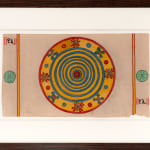Anonymous
A Jain Mandala , 20th Century
Ink and opaque pigments on paper
16.5 x 29.3 cm
6 1/2 x 11 1/2 in
6 1/2 x 11 1/2 in
£ 600.00
The ultimate objective of both Jainism and Buddhism is to obtain nirvana by escaping the cycle of rebirths. Jains venerate a sequence of twenty-four Jinas, who are teachers who have...
The ultimate objective of both Jainism and Buddhism is to obtain nirvana by escaping the cycle of rebirths. Jains venerate a sequence of twenty-four Jinas, who are teachers who have traversed the chasm between samsara (the phenomenal world) and liberation by nonviolence and asceticism. Among the most prominent types of Jain painting are manuscripts depicting cosmological themes.
Folio two in the current manuscript depicts the middle realm of the universe according to Jain cosmology. The middle world, situated between the celestial realm and the lower world of the damned, is where mortals and all sentient beings reside and from which emancipation is possible. The land is safeguarded with the wisdom of the Tirthankaras, as symbolized by the situation of Jain shrines on the four cardinal directions. The second lot (folio number 13 in the manuscript) comprises of a series of concentric circles representing the various continents and oceans. In the centre lies the continent of Jambudvipa, location of Mount Meru.
Folio two in the current manuscript depicts the middle realm of the universe according to Jain cosmology. The middle world, situated between the celestial realm and the lower world of the damned, is where mortals and all sentient beings reside and from which emancipation is possible. The land is safeguarded with the wisdom of the Tirthankaras, as symbolized by the situation of Jain shrines on the four cardinal directions. The second lot (folio number 13 in the manuscript) comprises of a series of concentric circles representing the various continents and oceans. In the centre lies the continent of Jambudvipa, location of Mount Meru.





